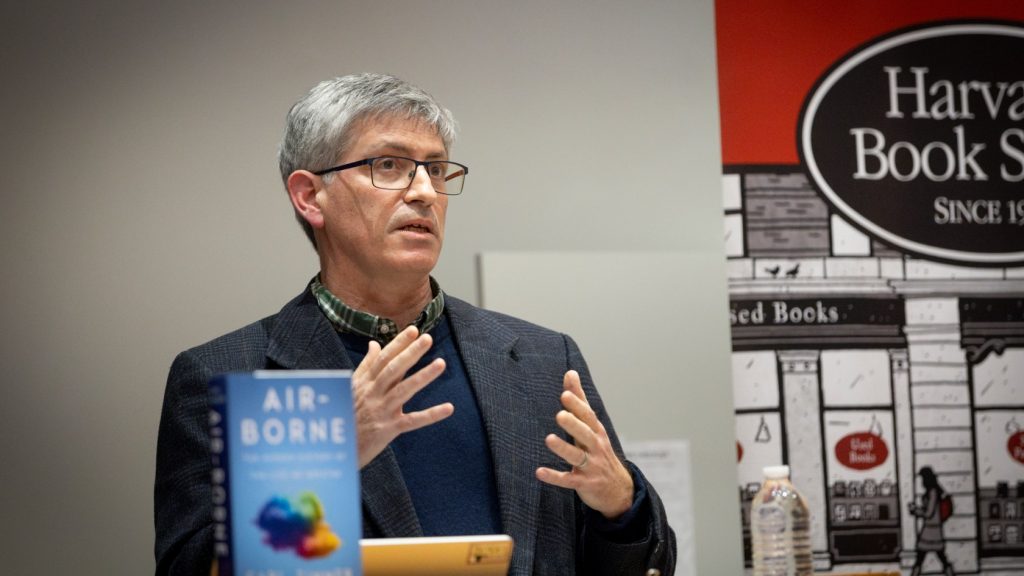Health
Did a socially awkward scientist set back airborne disease control?
Carl Zimmer.
Photos by Niles Singer/Harvard Staff Photographer
In talk on new book, Carl Zimmer theorizes key researcher’s discoveries were undercut by his personality
In the “Great Man” theory of history, outsized personalities make things happen. But when it comes to public acceptance of the science behind airborne diseases, Carl Zimmer hypothesized, a boring and unpleasant personality may have slowed progress.
Zimmer, the 2016 recipient of the Stephen Jay Gould Prize for his contributions to the public understanding of evolutionary science, did not set out to tell the story of one such person as he tracked our “long, slow, very difficult realization that the air around us is alive.” But in a recent talk about his new book, “Air-Borne: The Hidden History of the Life We Breathe,” he kept returning to former Harvard researcher William Firth Wells.
“Air has always been captivating and mysterious to us,” said Zimmer as he walked the audience at the Science Center through the main thread of his book: the discovery — and ultimate acceptance — of the concept that pathogens can be transmitted through the air.
In ancient Greece, Hippocrates first proposed the theory of “miasmas,” bad air that by itself carried sickness, rather than microorganisms carried by air, said Zimmer. Even more than a century after the discovery of microbes, in the 1830s when cholera struck Europe, the idea that the disease was transmitted through the air was not taken seriously. That began to change with the research of scientists such as Gottfried Ehrenberg, who in the 1830s began the first systematic study of microorganisms, and Louis Pasteur, whom Zimmer credits with “championing the germ theory of disease.”
But air continued to be overlooked in responses to disease outbreaks. “Again and again these diseases were linked to microorganisms that were spread in food, in water, through sex … but not in the air.”
“Again and again these diseases were linked to microorganisms that were spread in food, in water, through sex … but not in the air.”
Enter the work of Wells, who with his wife, Mildred Weeks Wells, a medical doctor, began to experiment with a centrifuge. Wells’ earlier work, cleaning water to raise disease-free oysters, had led him to experiment with the device, and in 1934, while lecturing at the Harvard School of Public Health, he used one to sample the air of the hall three times. The first time was after he dispersed a sneezing powder in the air, the second once that powder had taken effect, and the third after the students had left. Cultivating the samples he gathered in the centrifuge, he found what he considered powerful evidence that human exhalations spread microbes through the air.
Unfortunately, Zimmer said, “It was a terrible lecture.” Quoting a note by the dean of the School at the time, David Linn Edsall, he read, “This is the type of work Wells does extremely badly.” Further describing Wells as the type of person who could “talk for hours,” Zimmer went on to chronicle how the professor’s off-putting personality repeatedly cost him positions, setting back what should have been groundbreaking research.
At Harvard, Wells developed his theory of airborne infection and discovered that airborne pathogens could be killed by ultraviolet light. However, conflicts with his boss, Gordon McKay Professor of Sanitary Engineering Gordon Maskew Fair, over credit for these discoveries got him fired.
It was a pattern that would repeat for the rest of Wells’ life. At the University of Pennsylvania, where he next worked, he created “infection chambers” — airtight chambers that allowed researchers to control the ventilation reaching the animals inside — and again showed how airborne pathogens cause disease and how UV could destroy these pathogens. This research helped protect a school in 1940, when a measles outbreak hit Philadelphia. But when World War II broke out, and military researchers were desperate to keep soldiers healthy, the unpleasant Wells was once again excluded.
Only the arrival of his former assistant, Richard Riley, helped salvage his career. Together, they created a version of the infection chamber in a Baltimore Veterans Administration hospital. Isolating patients with tuberculosis, they controlled their ventilation — siphoning their air, and thus their contagions, into a separate chamber where guinea pigs were held. Sure enough, the animals contracted the disease, confirming the validity of Wells’ hypothesis. Unfortunately, before the research could become universally accepted, Wells fell ill from cancer and also started exhibiting psychotic episodes. In a cruel irony, he was treated and died in that same Baltimore VA hospital.
Taking questions about the future of such research — and about how dependent it is on the personalities of researchers and of so-called great men, Zimmer was not optimistic. “We’re a long ways off from the Wellses, but this kind of work takes years. It’s hard work. … And the pathogens don’t care.”
Zimmer is the adjunct professor of molecular biophysics and biochemistry at Yale and writes the “Origins” science column for The New York Times. The event was part of the FAS Division of Science’s Harvard Science Book Talks.



